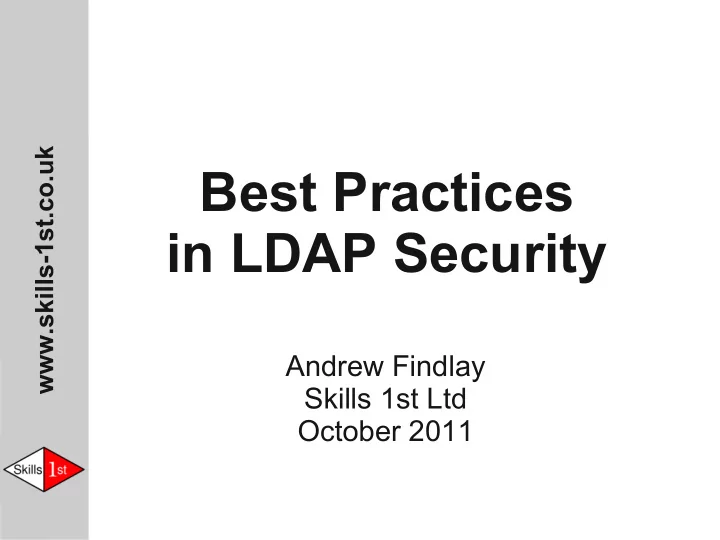

Best Practices in LDAP Security Andrew Findlay Skills 1st Ltd October 2011
What is "Security"? ● ISO/IEC 27000:2009 Information Security is... – Confidentiality – Integrity – Availability – And some other things
Controls ● A means of managing risk – Technical – Organisational – Legal ● Should be appropriately chosen
Accounts ● Must have automated update from an authoritative source ● Should never be deleted ● DNs should never be changed
Authentication ● Never let the password leave the client – The network is not to be trusted – The server may be compromised ● Use client-side certificates with TLS – Zero-knowledge proof – Can hold key in secure hardware ● Use TLS + Kerberos
If you must use passwords ● Use TLS + SASL SCRAM – Avoids exposing password to server ● Use TLS + simple bind – This really is the minimum acceptable ● Beware of non-ASCII passwords – LDAP treats passwords as binary blobs
Storing Passwords in LDAP ● Don't ● Don't store clear-text password ● AES256 is no better ● Always use a strong hash – SHA-1 OK for now – SHA-2 family current, SHA-3 coming ● Always use lots of salt
Enforcing Password Policies ● Draft-Behera ● Policy often conflicts with human factors – Humans are smart: they will win if you fight – Don't upset the good guys ● Don't do "n-strikes lockout" – Easily triggered by client config errors – Attackers are more subtle these days – Lockout and replication don't mix ● Password reset is often the weak link
Access Control ● Not standardised ● Even the simple schemes are complex ● Programmer territory – Use source-code control – Write test suites (and do it first ) – Treat ACL change like software upgrade ● ACLs may not be enough – Limits, Structure Rules etc.
DIT Design ● Common DIT structure is bad: CN=Smith,OU=Sales+L=Ipswitch,O=Telecom,C=UK ● Cannot hide DN content! ● Most servers cannot even hide entries
Replication ● Good for Read Availability – Resilience – Performance – Lower network round-trip time ● Less good for Write Availability – All servers must process all writes – Multi-master is a risk to Integrity ● Subset-replica – good for Confidentiality
Network ● Assume the network is compromised ● Firewalls are evil – Also necessary – Typically paranoid, breaking TCP rules
LDAP over SSL ● Don't do it – Never standardised – SSL is cryptographically weak – Deprecated ● Port 636 is no more 'secure' than 389 – If policy requires encryption then enforce with ACLs or server config ● SSL is still better than nothing :-( – Many clients still cannot do TLS
TLS ● Use it – always ● Run your own Certification Authority ● Clients must check server certs ● Use client-side certs for high-value accounts (server admin, replicator...) ● Don't trust any data obtained before TLS is established – re-read it
Server Setup ● Harden the OS ● Don't run LDAP server as root – CAP_NET_BIND_SERVICE ● Check file permissions ● Check backend DB permissions ● Check open-files limit ● Check add-on security settings (SELinux, AppArmor, etc)
Testing ● Build a permanent test suite – Access Control – Limits – Authentication – TLS ● Run all tests frequently during development ● Test the production service regularly ● Build a large set of dummy data for dev
Constant Service ● Design for 100% availability ● That includes non-stop through software upgrades ● Client machines may need proxies
Human Factors ● Legitimate users are a big risk – Educate them – Don't fight them ● Tight password policy is often bad ● LDAP server can only enforce simple policy – users must do the rest
Future Work ● Collect best practices ● Produce a checklist – Minimum requirements for all LDAP services – List of optional controls for higher security ● Submit checklist to SANS ● I need your help – www.ldap-best.org
Best Practices in LDAP Security www.ldap-best.org Andrew Findlay
Recommend
More recommend